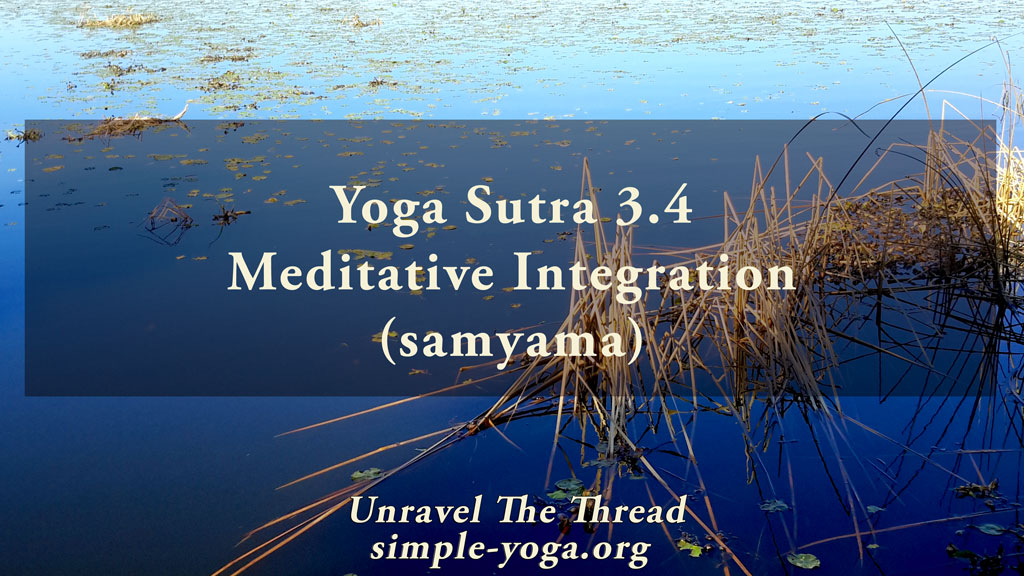
3.3 Samadhi – integration
June 12, 2021
3.5 Insight into higher wisdom
July 1, 2021
3.3 Samadhi – integration
June 12, 2021
3.5 Insight into higher wisdom
July 1, 20213.4 Meditative integration – samyama

3.4 Samyama (meditative integration) combines concentration (dharana), meditation (dhyana) and integration (samadhi).
Some of the meanings of Samyama include whole self-control, being equable, and neutrality. Samyama is a natural progression from concentration to meditation and then into the deep integration of samadhi. This meditative integration, samyama, is a process of concentrating on a meaningful focal point which can be a heartfelt intention, a mantra, an inspiring idea, a physical point in your own body, your breath, or anything uplifting as mentioned in sutras 1.34 to 1.39. Gradually you soften your grip of the focal point until your connection to it is as subtle as possible (dhyana – meditation). As you remain in that effortless focus, you eventually release the focal point into the wholeness, stillness and silence of pure awareness (samadhi – integration). This gradual process obviously requires the capacity to concentrate first without distractions, which will lead into the ability to remain focused with minimal effort. Once again, notice that many of the distractions disrupting the concentration process might be related to your opinions, your desire to become and sense of identity. If you are sitting watching as the sun sets, there is nothing you need to add to make that moment more beautiful, inspiring, or fulfilling. This is because there is no conflict in what is. Whatever is happening is a manifestation of the perpetual interaction between life and consciousness resulting from the confluence of a multitude of factors and previous events, most of them beyond your control and awareness. Similarly, there is no inherent conflict in the colors that you see, the scents you smell, or the flavors you taste. For instance, if you are used to drinking coffee every morning and for some reason you decide to stop drinking coffee for a few days, the same familiar aroma of coffee brewing that you welcome every morning can become a source of conflict in your own mind. Now that aroma of coffee feels inviting as it always does for you, but since you created a reason not to drink coffee this week, conflict arises, generating internal opinions and arguments between one aspect of you that wants to drink coffee and another aspect of you that wants to stick to your decision not to drink coffee at this time. These opposing perspectives within create a conflict that manifests as internal commentary, doubt, questioning, and perhaps even self-blame.
The same theme from aphorism 1.4 characterizes this process, when your ways of being are not modulated you tend to misidentify with the internal activities. This is a reminder that integration (samadhi) happens when your sense of identity dissolves by releasing opinions and preferences. Aphorism 3.4 reminds you also of sutra 2.2, yogic actions minimize afflictions, which are the fruit of misidentification. Attenuating those afflictions brings about integration (samadhi). Sutra 3.4 echoes also another theme in the Yoga Sutra, the complementarity of doing and being. Samyama is the transition between the doing of concentration (dharana), which gradually becomes subtler as meditation (dhyana), to lead into the result of just being, integration (samadhi). The basic premise is that the yogic process leads you from a superficial identification and understanding of who you are into presence, embodied awareness. This does not mean that you should give up on doing. Instead, it is an invitation to align with the conflict-free peace and clarity pervading your being and all that exists. As you participate in your life, you choose to maintain a clear connection to that conflict-free consciousness during all your actions. This is what sutra 2.1 suggests when it directs you to act with enthusiasm, wisdom, and humility.
The practice of meditative integration (samyama) develops naturally through the progression from concentration to meditation to integration (samadhi). Find a comfortable and sustainable position conducive to being relaxed, awake and aware. Connect to your natural breath. Choose a focal object that uplifts you and inspires you to contribute your best to your life and to the world. Hold that intention in your heart and mind with care and love. Focus on the sensations generated by your intention and gradually let go of your thoughts and stories about that object. Remain focused on the direct wordless experience of holding your intention in mind and heart, and keep returning to it after every single distraction. As you stay focused on sensations, be curious about the subtler sensations. Relaxed and aware, gradually soften your hold on your intention while still being curious about directly feeling the subtle sensations that arise. Let yourself be open, free of effort, and just be. Once you feel it is time to return to the boundaries of your physical body, lie down and relax for a few minutes.
What do you notice when you try this practice?
Are there any patterns in the distractors that emerge?
Can you practice without any expectations?
Does a regular practice make clarity more familiar and accessible?
As usual, one more way of exploring the meaning of this sutra is by chanting it.
You can choose to chant it in its traditional form with some of the words coming together:
3.4 trayamekatra saṃyamaḥ
त्रयमेकत्र संयमः ॥४॥
Another option is to chant each word in the sutra individually:
- trayam
- ekatra
- saṃyamaḥ
If you prefer, you may listen to the podcast:
Unravel the thread is now available as a book!
If you find Simple-Yoga.org and Unravel the thread useful, consider supporting my labor with a donation, you may also donate using PayPal or Venmo. Thank you!
